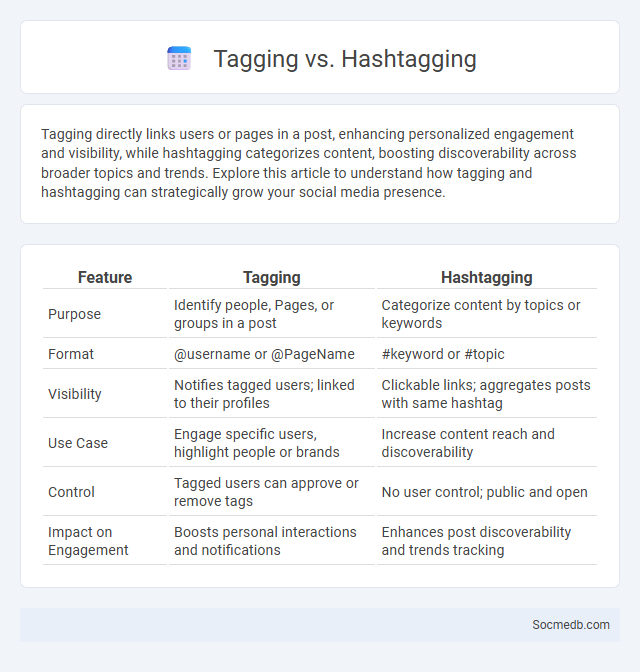
Photo illustration: Tagging vs Hashtagging
Tagging directly links users or pages in a post, enhancing personalized engagement and visibility, while hashtagging categorizes content, boosting discoverability across broader topics and trends. Explore this article to understand how tagging and hashtagging can strategically grow your social media presence.
Table of Comparison
| Feature | Tagging | Hashtagging |
|---|---|---|
| Purpose | Identify people, Pages, or groups in a post | Categorize content by topics or keywords |
| Format | @username or @PageName | #keyword or #topic |
| Visibility | Notifies tagged users; linked to their profiles | Clickable links; aggregates posts with same hashtag |
| Use Case | Engage specific users, highlight people or brands | Increase content reach and discoverability |
| Control | Tagged users can approve or remove tags | No user control; public and open |
| Impact on Engagement | Boosts personal interactions and notifications | Enhances post discoverability and trends tracking |
Understanding Tagging: Definition and Functions
Tagging on social media refers to the process of linking or mentioning other users, posts, or topics within content to increase visibility and engagement. This function enhances content discoverability, facilitates user interaction, and helps categorize posts for targeted audience reach. Effective tagging improves network connections and boosts algorithmic promotion by associating relevant keywords and users.
What is Hashtagging? Core Concepts Explained
Hashtagging involves using the "#" symbol followed by a keyword or phrase to categorize and make social media content easily discoverable. This core concept enables users to connect with specific topics, trends, or communities, increasing the visibility and engagement of Your posts. Effective hashtagging boosts content reach by linking it to relevant conversations across platforms like Instagram, Twitter, and LinkedIn.
The Evolution of Tagging: From Web Pages to Social Media
Tagging has evolved from simple web page categorization to dynamic social media metadata, enabling more precise content discovery and user interaction. Early web tags facilitated basic indexing, while modern social media tags, such as hashtags and user mentions, drive real-time engagement and trend tracking across platforms like Twitter, Instagram, and Facebook. This semantic shift has transformed tagging into a powerful tool for personalized marketing, social networking, and data analytics.
Key Differences Between Tagging and Hashtagging
Tagging involves directly linking an individual's profile to a post, enabling personal notifications and increasing engagement by explicitly mentioning users. Hashtagging categorizes content by keywords preceded by the "#" symbol, enhancing discoverability across social media platforms and aggregating posts under a common theme. Both techniques boost visibility but serve distinct purposes: tagging targets specific users, while hashtagging targets broader topical conversations.
Where to Use Tagging: Platforms and Best Practices
Tagging is highly effective on platforms such as Instagram, Facebook, Twitter, and LinkedIn, where it enhances content visibility and audience engagement. On Instagram and Facebook, tagging relevant users or brands boosts reach and fosters community interaction, while on Twitter, it helps initiate conversations and trending topics. LinkedIn tagging is best used for professional networking, highlighting collaborators, or acknowledging contributions in posts and updates.
Effective Hashtagging: Strategies for Maximum Reach
Effective hashtagging boosts your social media reach by targeting specific keywords and trending topics relevant to your niche. Utilizing a mix of popular, niche, and branded hashtags enhances content discoverability and engagement with your audience. Researching hashtag performance and analyzing competitor usage ensures strategic selection for maximum visibility.
Tagging vs Hashtagging in Content Organization
Tagging in social media involves directly linking users or pages to specific content, enhancing personalized engagement and network visibility, while hashtagging categorizes posts under thematic keywords, improving content discoverability across broader audiences. Effective tagging helps build community connections and encourages interaction by notifying tagged individuals, whereas strategic hashtagging boosts organic reach by grouping related discussions and trending topics. Both techniques optimize content organization by enabling targeted searches and fostering user participation within social networks.
Impact on SEO: Tags vs Hashtags
Tags and hashtags play distinct roles in social media's impact on SEO, with tags primarily organizing content within platforms and hashtags enhancing discoverability across broader audiences. Using relevant hashtags can boost your content's visibility by linking it to trending topics and user searches, increasing organic reach and potential backlinks. Optimizing your SEO strategy involves strategically selecting both tags and hashtags to improve content indexing and engagement on search engines and social platforms.
Common Mistakes in Tagging and Hashtagging
Common mistakes in tagging and hashtagging on social media include overusing irrelevant hashtags, which can reduce engagement and confuse your target audience. Many users also fail to tag relevant accounts properly, missing opportunities for increased visibility and collaboration. To optimize your social media impact, ensure your tags and hashtags are specific, relevant, and strategically aligned with your content and audience.
Choosing the Right Method: Tagging, Hashtagging, or Both?
Choosing the right method between tagging, hashtagging, or combining both enhances your social media engagement by targeting specific audiences and boosting content visibility. Tagging connects your posts directly to other users or brands, fostering personal interaction, while hashtags categorize content, making it discoverable to broader communities and trending topics. Employing a strategic blend of tagging and hashtagging maximizes reach and strengthens your brand's online presence.
 socmedb.com
socmedb.com